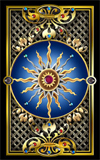History of Tarot and Cartomancy
The Tarot, a deck of 78 ornate and mysterious cards, has long fascinated and perplexed humanity. Its history is veiled in the mists of time, shrouded in myth, and intertwined with both divination and mysticism. This article embarks on a journey through the rich and enigmatic history of Tarot, from its uncertain origins to its enduring presence in our world.The Origins of Tarot
The origins of Tarot are a subject of much debate and speculation. While the exact birthplace of Tarot remains elusive, it is widely believed to have emerged in Europe during the late 14th century. The earliest surviving Tarot decks, known as Tarot de Marseille, were created in France in the 15th century.
Some theories suggest that Tarot cards have their roots in ancient Egypt, while others point to the influence of Islamic mysticism. One of the most enduring and romanticized theories attributes the creation of the Tarot to the Romani people, often referred to as Gypsies. This theory has become entrenched in the lore of Tarot, leading to the frequent use of terms like "Gypsy Tarot."
The Evolution of Tarot
The Tarot started as a deck of playing cards, much like the modern deck of playing cards used for games such as poker and bridge. However, it didn't take long for Tarot to evolve beyond mere gaming. By the 18th century, Tarot cards had become linked with esoteric and mystical practices, particularly in France, where the Tarot de Marseille became closely associated with divination and occultism. One of the most influential figures in the evolution of Tarot was Antoine Court de Gébelin, a French clergyman and Freemason who, in the late 18th century, argued that the Tarot contained hidden knowledge, connecting it to ancient Egyptian mysticism. His ideas contributed to the Tarot's transformation from a simple card game to a tool for esoteric exploration.
The Influence of Tarot in the Occult World
The 19th century witnessed a resurgence of interest in the Tarot, largely driven by the burgeoning spiritual and occult movements of the time. The Tarot found its way into the hands of prominent occultists and mystics who were eager to unlock its secrets.
One of the most notable figures in the Tarot's occult history is Éliphas Lévi, a French occultist and author who linked Tarot with the Kabbalah, a form of Jewish mysticism. Lévi's writings laid the groundwork for the Tarot's association with esoteric symbolism, and his influence can still be felt in modern Tarot interpretations.
The Rider-Waite Tarot deck, created by Arthur Edward Waite and illustrated by Pamela Colman Smith in 1910, is perhaps the most iconic and widely recognized Tarot deck in the world. This deck introduced a new level of symbolism and imagery to the cards, making it more accessible to a broader audience and solidifying the Tarot's status as a tool for divination and self-discovery.
Modern Tarot and Its Popularity
In the 20th and 21st centuries, Tarot continued to evolve and adapt to changing times. Today, there are countless Tarot decks available, each with its own unique artwork and symbolism. The Tarot has found its way into popular culture, appearing in books, films, and television shows. It is no longer confined to esoteric circles but is readily accessible to anyone interested in its mysteries.
Benefits and Uses of Tarot
The Tarot has proven to be a versatile tool with various uses. While it is often associated with divination and fortune-telling, it serves a broader purpose in modern times:
1. Self-Reflection and Guidance: Tarot cards can provide insights into personal challenges, decisions, and potential outcomes, allowing individuals to reflect on their lives and seek guidance.
2. Creative and Spiritual Exploration: Many artists, writers, and spiritual seekers use Tarot as a source of inspiration and a means of exploring their creative and spiritual depths.
3. Decision-Making: Tarot can assist in making informed decisions by offering different perspectives and potential consequences for various choices.
4. Emotional Healing: The process of reading Tarot cards can aid in emotional healing and self-acceptance, helping individuals confront and overcome emotional hurdles.
Conclusion
The history of Tarot is a fascinating journey through time, filled with mystery, symbolism, and transformation. From its humble beginnings as a deck of playing cards to its current status as a tool for self-discovery and insight, Tarot has left an indelible mark on our cultural and spiritual landscape. Whether you view Tarot as a source of divination or a means of personal exploration, its enduring allure continues to captivate and inspire individuals around the world. The Tarot's past is as rich and complex as the cards themselves, inviting us to uncover its hidden wisdom and embrace its enduring mystique.
Select your cards









































